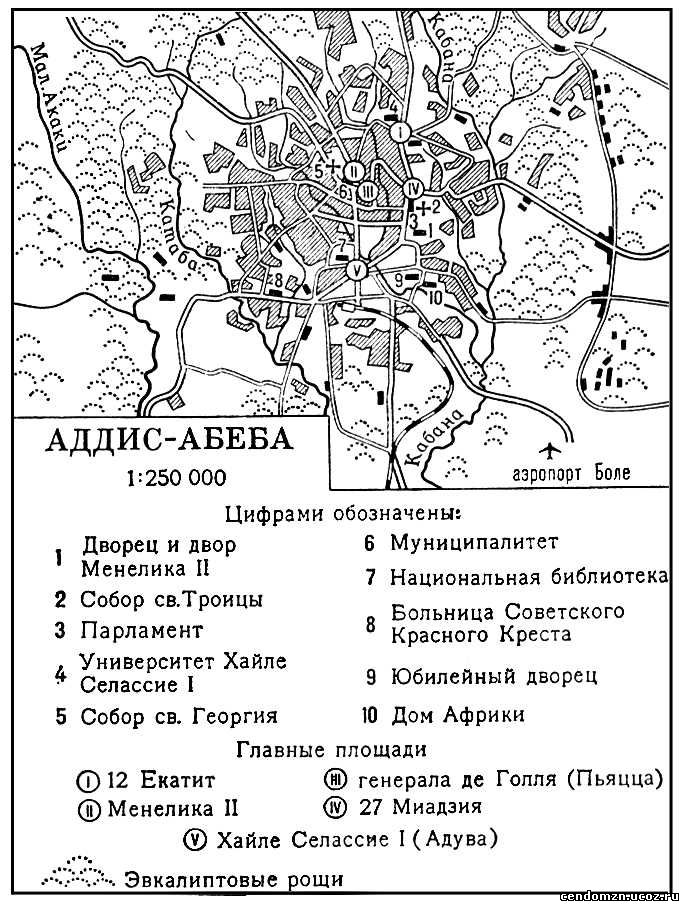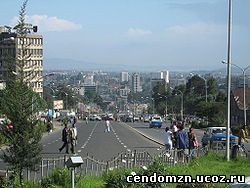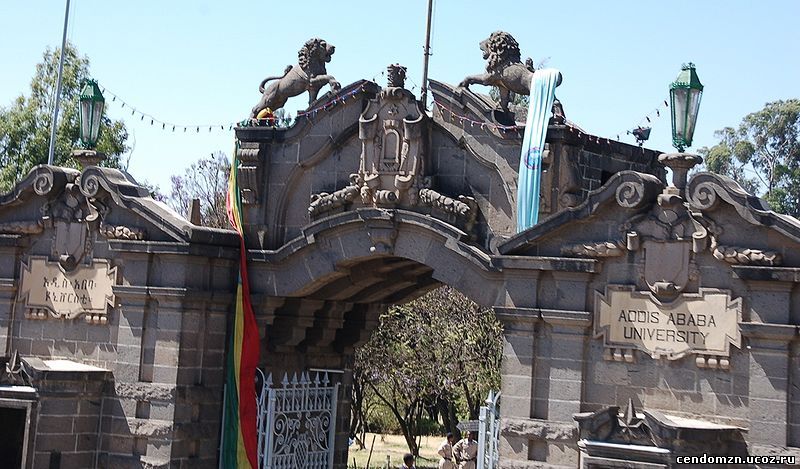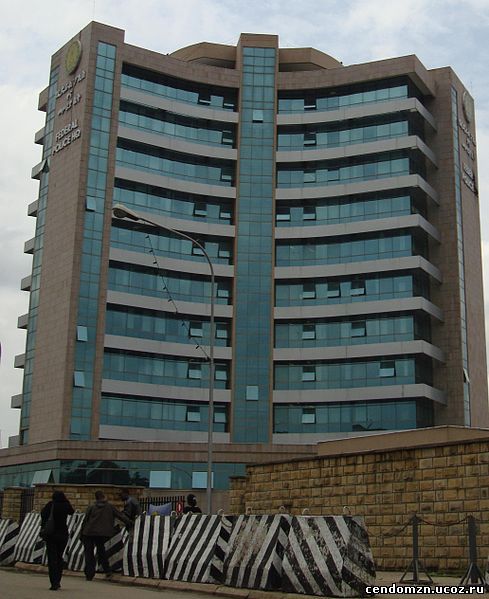 Аддис-Абеба (амхарск. — новый
цветок), столица Эфиопии, крупнейший
город, промышленный и культурный центр
страны. Расположена на Эфиопском нагорье
на высоте свыше 2400 м. 664 тыс. жителей
(1968; около 400 тыс. жителей в 1958). Узел
автодорог; железная дорога на порт
Джибути (Сомали франц.). Аэропорт
международного значения. В А. сосредоточены
в основном предприятия лёгкой (текстильной,
кожно-обувной), пищевой (мукомольной,
маслобойной, мясо-молочной),
деревообрабатывающей и стройматериалов
промышленности. Кустарное производство
ткацких, коженных, керамических,
металлических и деревянных изделий.
Торговля кофе, шкурами, зерном, масличными,
мёдом, скотом, кустарными изделиями.
Аддис-Абеба (амхарск. — новый
цветок), столица Эфиопии, крупнейший
город, промышленный и культурный центр
страны. Расположена на Эфиопском нагорье
на высоте свыше 2400 м. 664 тыс. жителей
(1968; около 400 тыс. жителей в 1958). Узел
автодорог; железная дорога на порт
Джибути (Сомали франц.). Аэропорт
международного значения. В А. сосредоточены
в основном предприятия лёгкой (текстильной,
кожно-обувной), пищевой (мукомольной,
маслобойной, мясо-молочной),
деревообрабатывающей и стройматериалов
промышленности. Кустарное производство
ткацких, коженных, керамических,
металлических и деревянных изделий.
Торговля кофе, шкурами, зерном, масличными,
мёдом, скотом, кустарными изделиями.
А. основана в 1887. Император Менелик II в 1889 перенёс сюда столицу Эфиопии. В мае 1963 в А. состоялась конференция глав государств и правительств африканских стран, на которой была учреждена Организация африканского единства (ОАЕ).
В городе одноэтажная застройка (глинобитная, каменная, деревянная) сочетается с немногими многоэтажными современными зданиями, среди которых — государственный банк, муниципалитет, телевизионный центр, МИД, Торговая палата (все — 1965), Дом Африки (1963) с огромным витражом (150 м2, по эскизу Афеворка Текле) и др. На Ю. — пл. Хайле Селассие I (площадь Адува) с каменной статуей льва (символ эфиопской государственности). В центре — площадь Менелика II с конной статуей Менелика II, собором святого Георгия (конец 19 в., реставрирован в 1950-е гг., расписан Афеворком Текле и Миллафом Херойу); на В. — собор святой Троицы (1941), дворец Менелика II (1894), площадь 27 Миадзия с монументом в память освобождения от итальянской оккупации. На площади 12 Екатит — памятник жертвам фашизма (1955, скульптор А. Августинчич).
В А. — университет, университетская и Национальная библиотеки, Историко-этнографический музей, Национальный театр. Институт эфиопистики (1963). С 1958 А. — резиденция Экономической комиссии ООН для Африки, с 1963 резиденция ОАЕ.
Аддис-Абеба (амх. አዲስ አበባ), столица Эфиопии и Африканского союза, а также его предшественника — Организации африканского Единства. С населением 3 627 934 жителей является крупнейшим в мире городом, расположенным в стране, не имеющей выхода к морю. Имеет статус отдельного региона Эфиопии.
Основан в 1886 году императором Менеликом II по просьбе его жены — императрицы Таиту.
А.-А. часто называют «столицей Африки» или «Парижем Африки» в связи с его историческим, политическим и дипломатическим значением для континента. Город населяют люди множества национальностей из разных регионов Эфиопии: амхара, оромо, Тиграи,сомали и многие другие. Богат также конфессиональный состав населения: здесь живут монофизиты, мусульмане, иудеи, православные христиане, протестанты и приверженцы традиционных африканских верований.
 Общий вид города
Общий вид города
А.-А. — это одна из самых высокогорных столиц в мире. Самая нижняя точка города — 2326 м, расположена на юге города, где находится аэропорт Боле. Самая высокая точка — гора Энтото с высотой 3000 м, расположенная на севере города.
А.-А. была основана императором Эфиопии Менеликом II. Первоначальное название города звучало как Финфин, что на языкеоромо означает «горячие источники». Менелик II, который в это время был царем государства Шева, считал окрестности горы Энтото удобной базой для военных операций на юге его царства. В 1879 году он посетил руины известного средневекового города и остатки церкви в этом районе. Его интерес к этому региону возрос после того, как императрица Таиту начала строительство церкви на горе Энтото. Однако природные условия не позволяли строить город в непосредственной близости от горы. В 1886 году строительство началось к югу от гор.
Первоначально Таиту построила дом для себя в окрестностях минеральных источников «Филуоха», где она и члены Королевского суда любили принимать минеральные ванны. Другие знатные люди селились рядом с домом Таиту. Когда поселение расширилось, Менелик IIперестроил дом Таиту во дворец, где сегодня располагается правительство Эфиопии. Современное название — А.-А. что в переводе с амхарского языка означает Новый цветок, и титул столицы Эфиопии город принял, когда Менелик II стал императором Эфиопии. До сих пор можно увидеть эвкалипты вдоль городских улиц, посаженные императором Менеликом II.
5 мая 1936 года в ходе Второй итало-эфиопской войны итальянские войска заняли город. В период с 1936 по 1941 год А.-А. была столицей Итальянской Восточной Африки. За этот период около миллиона эфиопов были убиты горчичным газом. После победы британских войск и эфиопских повстанцев над итальянской армией в Эфиопии император Хайле Селассие вернулся в столицу и сразу начал работы по восстановлению города и прежней жизни.
При поддержке Хайле Селассие в 1963 была создана Организация Африканского Единства, штаб-квартира которой разместилась в А.-А. В 2002 году ОАЕ была распущена, а вместо неё был организован Африканский Союз со штаб-квартирой в А.-А. Также в городе расположена Экономическая комиссия ООН для Африки. А в 1965 году в А.-А. был проведен Совет Восточных православных церквей.
Город имеет целый комплекс сложных климатических явлений, так как расположен на высокогорье. В зависимости от высоты и преобладающего ветра температура может отличаться на 10 °C. В целом температура в течение года примерно одинаковая, без резких колебаний. Среднемесячная температура меняется от +16 до +19 °C в зависимости от времени года. Расположение вблизи экватораобеспечивает достаточно тепла, несмотря на высокогорное положение. Растительность в пределах города довольно бедная, представлена пустынными и полупустынными кустарниками и травами. Колебаний температуры в течение года практически нет. В городе не бывает палящего зноя и почти не бывает холодов, редко — заморозки.
Основываясь на данных Центрального статистического агентства Эфиопии, опубликованных в 2008 году, население А.-А. составляло 3 147 000 жителей, из них 1 511 000 мужчин и 1 636 000 женщин. В настоящее время на территории А.-А. не существует сельских районов, поэтому 100 % населения — городское. Здесь проживает 23 % всего городского населения Эфиопии. Площадь города — 540 км² и плотность населения составляет 5936 чел./км².
Со времени последней переписи населения Эфиопии, которая прошла в 1994 году, население А.-А. выросло почти на 1 млн жителей. В1994 году население столицы составляло около 2,3 млн.жителей, из которых 28 149 проживало в сельских районах города. В столице проживают представители множества национальностей. Среди них выделяются: амхара — 48,3 % населения, оромо — 19,2 %, гураге — 17,5 %, тиграи — 7,6 %. монофизиты составляют 82 % населения, мусульмане — 12,7 %, протестанты — 3,9 %, католики — 0,8 %.
Динамика численности населения А.-А.:
1900 — 80 000 жителей
1958—400 000 жителей
1968—664 000 жителей
2002 — 1 700 000 жителей.
2008 — 3 147 000 жителей
В А.-А. присутствует разнообразная экономическая деятельность. Согласно официальной статистике федерального правительства, около 119197 человек заняты в торговле и коммерции, 113977 человек — в промышленности, 80391 человек имеют свое домохозяйство, 71186 человек заняты в администрации, 50538 человек — в транспорте и коммуникациях, 42514 человек — в области социального обеспечения, 32685 человек заняты в гостиничном хозяйстве и туризме, а 16602 человек работают в сельском хозяйстве.
Множество бедных эфиопов из сельских районов приезжают в А.-А. в поисках заработка и заполняют улицы эфиопской столицы. Хотя в последнее время число нищих уменьшилось благодаря обеспечению их образованием и работой. Сегодня А.-А. относительно чистый и безопасный город Африки, где наиболее распространены такие преступления как мошенничество, мелкие кражи и воровство сумок.
В последнее время растет количество высотных зданий и дорогих гостиниц. Ведется строительство торговых центров и развлекательных клубов. А.-А. все чаще называют «Курортной столицей Африки».
Общественный транспорт состоит из автобусов и маршрутных такси синего или белого цветов. Маршрутные такси это, как правило, микроавтобусы, вмещающие около 12 пассажиров. В каждом маршрутном такси есть кондуктор, собирающий плату за проезд.
В начале 2008 года в сотрудничестве с Россией был открыт первый троллейбусный маршрут — «Геородис — Адису Гебея».
Международный аэропорт Боле обслуживает А.-А. и ближайшие города, и является главными воздушными воротами страны. В2003 году здесь был открыт новый международный пассажирский терминал — один из самых современных в Африке. Также планируется открыть воздушное сообщение А.-А. с Москвой. На западе города расположен старый аэропорт Лидета, используемый в настоящее время для военных целей и небольших самолетов.
Также А.-А. имеет железнодорожное сообщение с Джибути и Дыре-Дауа. Вокзал города построен в живописном французском стиле.
 Университет Аддис-Абебы
Университет Аддис-Абебы
Университет А.-А. был основан в 1950 году и первоначально носил название «Университетский колледж Аддис-Абебы». В 1962 году он был переименован в Университет А.-А. Здесь расположено 6 университетских городков и 1 кампус находится в городе Дэбрэ-Зейт. Также во многих городах Эфиопии расположены филиалы этого университета.
В А.-А. расположен Институт эфиопских исследований и этнографический музей. Также есть множество частных колледжей.
В Национальном музее хранится гипсовая копия Люси — австралопитека, найденного на территории Эфиопии. На сегодняшний день это древнейший человек, чьи останки были найдены.
Также здесь расположена Эфиопская национальная библиотека и этнографический музей, музей А.-А., музей Эфиопии и музей естественной истории. Богатые коллекции находятся в железнодорожном музее и почтовом музее.
Примечательным является здание Георгиевского собора, основанного в 1896 году. В Свято-Троицком соборе находится захоронение императора Хайле Селассие. Крупнейшим католическим собором является собор Святого Семейства. Здесь расположена крупнейшая мечеть Эфиопии — Анвар.
Другая достопримечательность города — рынок Меркато, основанный в период итальянского господства в Эфиопии.
Крупнейшее спортивное сооружение — стадион А.-А., где в 2008 году был проведен чемпионат Африки по легкой атлетике.
Addis Ababa (sometimes spelled Addis Abeba, the spelling used by the official Ethiopian Mapping Authority) is the capital city of Ethiopia. (In Ethiopian languages: Amharic, Addis Abäba [adːiːs aβəβa] "new flower"; Oromo, Finfinne[citation needed]; Ge'ez ኣዲስ ኣበባ) It is the largest city in Ethiopia, with a population of 3,384,569 according to the 2007 population census.
As a chartered city (ras gez astedader), Addis Ababa has the status of both a city and a state. It is where the African Union and its predecessor the OAU are based. Addis Ababa is therefore often referred to as "the political capital of Africa", due to its historical, diplomatic and political significance for the continent. The city is populated by people from different regions of Ethiopia – the country has as many as 80 nationalities speaking 80 languages and belonging to a wide variety of religious communities. It is home to Addis Ababa University. The Federation of African Societies of Chemistry (FASC) and Horn of Africa Press Institute (HAPI) are also headquartered in Addis Ababa.
Ethnic Oromo Ethiopians had lived on the land before the foundation of Addis Ababa. They lived in a small settlement known under the Oromo name Finfinne. Other parts were called Fil wiha ("hot springs") in Amharic.
 Штаб-квартира федеральной полиции Эфиопии
Штаб-квартира федеральной полиции Эфиопии
Menelik, as Negus of Shewa, had found Mount Entoto a useful base for military operations in the south of his realm. In 1879, Menelik visited the reputed ruins of a medieval town and an unfinished rock church that showed proof of an Ethiopian presence in the area prior to the campaigns of Ahmad Gragn. His interest in the area grew when his wife Taytu began work on a church on Entoto. In addition, Menelik endowed a second church in the area. In 1881, Menelik moved the capital of Shewa from Ankober to Entoto.
The immediate area around Entoto did not encourage the founding of a town due to the lack of firewood and water. In 1886, the actual settlement began in the valley south of the mountain. Taytu initially built a house for herself near the Filwoha hot mineral springs, where she and members of the Shewan royal court liked to take mineral baths. Soon, other members of the Shewan nobility and their staffs and households settled the vicinity. Negus Menelik expanded his wife's house to become the Imperial Palace, which remains the seat of government in Addis Ababa today. Between 1889 and 1891, Addis Ababa became Ethiopia's capital when Menelik II became Emperor of Ethiopia. One of Emperor Menelik's contributions that is still visible today is the planting of numerous eucalyptus trees along the city streets.
After becoming the capital of Ethiopia, Addis Ababa grew by leaps and bounds and took on the character of a boomtown. By 1910, the city had approximately 70,000 permanent inhabitants and also had between 30,000 to 50,000 temporary inhabitants. Addis Ababa became the site of many of Ethiopia's innovations.
On 5 May 1936, Italian troops occupied Addis Ababa during the Second Italo-Abyssinian War, making it the capital of Italian East Africa. Addis Ababa was governed by the Italian Governors of Addis Ababa from 1936 to 1941. After the Italian army in Ethiopia was defeated by the British army (with the help of Arbegnoch), during the Liberation of Ethiopia, Emperor Haile Selassie returned to Addis Ababa on 5 May 1941—five years to the very day after he had departed—and immediately began the work of re-establishing his capital.
Emperor Haile Selassie helped form the Organization of African Unity in 1963, and invited the new organization to keep its headquarters in the city. The OAU was dissolved in 2002 and replaced by theAfrican Union (AU), also headquartered in Addis Ababa. The United Nations Economic Commission for Africa also has its headquarters in Addis Ababa. Addis Ababa was also the site of the Council of the Oriental Orthodox Churches in 1965.
Addis Ababa lies at an altitude of 7,546 feet (2,300 metres) and is a grassland biome, located at 9°1′48″N 38°44′24″ECoordinates: 9°1′48″N 38°44′24″E. The city lies at the foot of Mount Entoto. From its lowest point, around Bole International Airport, at 2,326 metres (7,631 ft) above sea level in the southern periphery, the city rises to over 3,000 metres (9,800 ft) in the Entoto Mountains to the north.
Addis Ababa has a Subtropical highland climate (Koppen Cwb). The city possesses a complex mix of highland climate zones, with temperature differences of up to 10 °C, depending on elevation and prevailing wind patterns. The high elevation moderates temperatures year-round, and the city's position near theequator means that temperatures are very constant from month to month. Based on the 2007 Census conducted by the Central Statistical Agency of Ethiopia (CSA), Addis Ababa has a total population of 2,739,551, of whom 1,305,387 are men and 1,434,164 women; all of the population are urban inhabitants. For the capital city 662,728 households were counted living in 628,984 housing units, which results in an average of 4.1 persons to a household. Although all Ethiopian ethnic groups are represented in Addis Ababa due to its position as capital of the country, the largest groups include the Amhara (47.04%%), Oromo (19.51%), Gurage (16.34%), Tigray(6.18%), Silt'e (2.94%), and Gamo (1.68%). Languages spoken include Amharic (71.0%), Oromiffa (10.7%), Gurage (8.37%), Tigrinya (3.60%), Silt'e (1.82%) and Gamo (1.03%). The religion with the most believers in Addis Ababa is Ethiopian Orthodox with 74.7% of the population, while 16.2% are Muslim, 7.77% Protestant, and 0.48% Catholic.
In the previous census, conducted in 1994, the city's population was reported to be 2,112,737, of whom 1,023,452 were men and 1,089,285 were women. At that time not all of the population were urban inhabitants; only 2,084,588 or 98.7% were. For the entire administrative council there were 404,783 households in 376,568 housing units with an average of 5.2 persons per household. The major ethnic groups included the Amhara (48.3%), Oromo (19.2%), Gurage (13.5%; 2.3% Sebat Bet, and 0.8% Sodo), Tigray 7.64%, Silt'e 3.98%, and foreigners from Eritrea 1.33%. Languages spoken included Amharic (72.6%), Oromiffa (10.0%), Gurage (6.54%), Tigrinya (5.41%), and Silt'e 2.29%. In 1994 the predominant religion was also Ethiopian Orthodox with 82.0% of the population, while 12.7% were Muslim, 3.87% Protestant, and 0.78% Catholic.
According to the 2007 national census, 98.64% of the housing units of Addis Ababa had access to safe drinking water, while 14.9% had flush toilets, 70.7% pit toilets (both ventilated and unventilated), and 14.3% had no toilet facilities. Values for other reported common indicators of the standard of living for Addis Ababa as of 2005 include the following: 0.1% of the inhabitants fall into the lowest wealth quintile; adult literacy for men is 93.6% and for women 79.95%, the highest in the nation for both sexes; and the civic infant mortality rate is 45 infant deaths per 1,000 live births, which is less than the nationwide average of 77; at least half of these deaths occurred in the infants’ first month of life.
The economic activities in Addis Ababa are diverse. According to official statistics from the federal government, some 119,197 people in the city are engaged in trade and commerce; 113,977 in manufacturing and industry; 80,391 homemakers of different variety; 71,186 in civil administration; 50,538 in transport and communication; 42,514 in education, health and social services; 32,685 in hotel and catering services; and 16,602 in agriculture. In addition to the residents of rural parts of Addis Ababa, the city dwellers also participate in animal husbandry and cultivation of gardens. 677 hectares (1,670 acres) of land is irrigated annually, on which 129,880 quintals of vegetables are cultivated.[citation needed] It is a relatively clean and safe city, with the most common crimes being pickpocketing, scams and minor burglary. The city has recently been in a construction boom with tall buildings rising in many places. Various luxury services have also become available and the construction of shopping malls has recently increased. According to Tia Goldenberg of IOL, area spa professionals said that some people have labelled the city, "the spa capital of Africa."
Ethiopian Airlines has its headquarters on the grounds of Bole International Airport in Addis Ababa.
Arkebe Oqubay was a Mayor of Addis Ababa, Ethiopia. He held office from early 2003 to May 2005. On March 31, 2005, Arkebe Oqubay was named "African Mayor of 2005" by Broadcasting Network of Africa. Mayor Oqubay lost the mayorship of Addis Ababa in May 2005 to Berhanu Nega, but after boycotting the parliament Berhanu Nega's C.U.D. or Kinijit party did not take control of the city government. The leaders of the CUD, his opposition party which swept the election in the capital, were later imprisoned and not permitted to assume control of the city. They were pardoned and released after two years in prison.
Though most of the CUD refused to join the parliament, factions of CUD and all the rest of opposition parties joined parliament in 2005. The government has appointed a provisional city government with Berhanu Deresa the acting Mayor.
Addis Ababa is the headquarters of the United Nations Economic Commission for Africa and the African Union. The fossilized skeleton, and a plaster replica of the early hominid Lucy (known in Ethiopia as Dinkinesh) is preserved at the Ethiopian National Museum in Addis Ababa. Meskel Square is one of the noted squares in the city and is the site for the annual Meskel at the end of September annually when thousands gather in celebration.
The city is home to the Ethiopian National Library, the Ethiopian Ethnological Museum (and former palace), the Addis Ababa Museum, the Ethiopian Natural History Museum, the Ethiopian Railway Museum and the National Postal Museum. Notable buildings include St George's Cathedral (founded in 1896 and also home to a museum), Holy Trinity Cathedral (once the largest Ethiopian Orthodox Cathedral and the location of Sylvia Pankhurst's tomb) as well as the burial place of Emperor Haile Selassie and the Imperial family, and those who fought the Italians during the war. There is alsoMenelik's old Imperial palace which remains the official seat of government, and the National Palace formerly known as the Jubilee Palace (built to mark Emperor Haile Selassie's Silver Jubilee in 1955) which is the residence of the President of Ethiopia. The Hager Fikir Theatre, the oldest theatre in Ethiopia, is located at the Piazza district. Africa Hall is located across Menelik II avenue from this Palace and is where the United Nations Economic Commission for Africa is headquartered as well as most UN offices in Ethiopia. It is also the site of the founding of the Organisation of African Unity(OAU) which eventually became the African Union.
Near Holy Trinity Cathedral is the Parliament building, built during the reign of Emperor Haile Selassie, with its clock tower. It continues to serve as the seat of Parliament today. Across from the Parliament is the Shengo Hall, built by the Derg regime of Mengistu Haile Mariam as its new parliament hall. The Shengo Hall was the world's largest pre-fabricated building, which was constructed inFinland before being assembled in Addis Ababa. It is used for large meetings and conventions.
In the Merkato district, which happens to be the largest open market in Africa, is the impressive The Grand Anwar Mosque, the biggest mosque in Ethiopia. A few meters to the southwest of the Anwar Mosque is the Raguel Church. The Roman Catholic Cathedral of the Holy Family is also in the Merkato district. Near Bole International Airport is the new Medhane Alem (Savior of the World) Cathedral, which is the second largest in Africa.
Other features of the city include the large Merkato market, the Jan Meda Race Ground racecourse, Bihere Tsige Recreation Centre and a railway line to Djibouti. Sport facilities include Addis Ababaand Nyala Stadiums. The 2008 African Championships in Athletics were held in Addis Ababa. The Entoto Mountains start among the northern suburbs. Suburbs of the city include Shiro Meda andEntoto in the north, Urael and Bole (home to Bole International Airport) in the east, Nifas Silk in the south-east, Mekanisa in the south, and Keraniyo and Kolfe in the west.
The city hosts the We Are the Future center, a child care center that provides children with a higher standard of living. The center is managed under the direction of the mayor’s office, and the international NGO Glocal Forum serves as the fundraiser and program planner and coordinator for the WAF child center in each city. Each WAF city is linked to several peer cities and public and private partners to create a unique international coalition. Launched in 2004, the program is the result of a strategic partnership between the Glocal Forum, the Quincy Jones Listen Up Foundation and Mr. Hani Masri, with the support of the World Bank, UN agencies and major companies.
Addis Ababa University was founded in 1950 and was originally named "University College of Addis Ababa", then renamed in 1962 for the former Ethiopian emperor Haile Selassie I who had donated his Genete Leul Palace to be the University main campus in the previous year. It received its current name in 1975. Although the university has six of its seven campuses within Addis Ababa (the seventh is located in Debre Zeit, about 45 km/28 mi away), it also maintains branches in many cities throughout Ethiopia. It is the home of the Institute of Ethiopian Studies and the Ethnological Museum. The city also has numerous private colleges including Admas College, Ethiopian Civil Service College and Unity University. Public transportation is through public buses from Anbessa City Bus Service Enterprise or blue and white share taxis. The taxis are usually minibuses that can seat at most twelve people. Two people are responsible for each taxi, the driver and a weyala who collects fares and calls out the taxi's destination.
The construction of the Addis Ababa Ring Road was initiated in 1998 to implement the city master plan and enhance peripheral development. The Ring Road was divided into three major phases that connect all the five main gates in and out of Addis Ababa with all other Regions (Jimma, Debre Zeit, Asmara, Gojjamand Ambo). For this project, China Road and Bridge Corporation (CRBC) was the partner of Addis Ababa City Roads Authority (AACRA). The Ring Road has greatly helped to decongest and alleviate city car traffic.
Intercity bus service is provided by the Selam Bus Line Share Company.
The city is served by Bole International Airport, where a new terminal opened in 2003. The old Lideta Airport in the western "Old Airport" district is used mostly by small craft and military planes and helicopters. Addis Ababa also has had a railway connection with Djibouti City, with a picturesque French style railway station, but the railway no longer operates.
A light rail system is planned; in September 2010, Ethiopian Railway Corp reached a funding agreement with Export and Import Bank of China. Plans include a 30km network with two lines; an east-west line from Ayat to the Torhailoch ringroad, and from Menelik Square to Merkato Bus Station, Meskel Square and Akaki.